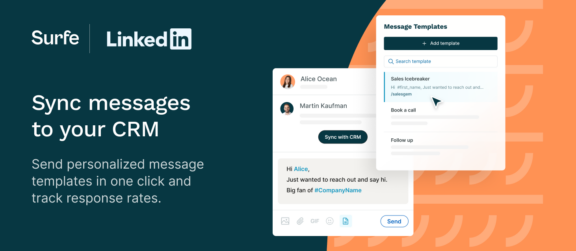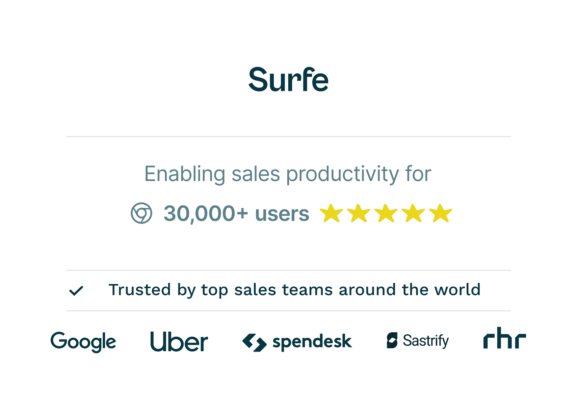Why Building a Post-Sale Relationship Could Be the Answer to More Revenue

For most people working in sales, the main focus of your job is closing deals. But while the excitement of sealing a contract or winning a new customer is undeniable, the real magic in business success happens after the sale.
Post-sale relationships, often overlooked, are critical to the longevity of your business. If you think the customer journey ends with a signature, think again. In reality, that’s just the beginning of building trust, loyalty, and more importantly, a pipeline of future opportunities.
The post-sale phase is where businesses transform customers into lifelong advocates, repeat buyers, and, ultimately, key drivers of long-term growth. By nurturing these relationships, sales teams can unlock a wealth of benefits, from increased customer satisfaction to upselling, referrals, and, perhaps most importantly, sustained business success.
Need to skip ahead? We’ll cover:
Retention vs. Acquisition: Why Existing Customers Are Your Most Valuable Segment
We’ve all heard the saying, “It’s cheaper to keep a customer than to acquire a new one.” And for good reason— acquiring new customers is expensive. Studies show that retaining an existing customer is anywhere from 5 to 25 times cheaper than bringing in a new one. Yet, too many businesses invest the lion’s share of their resources in acquisition rather than retention.
The numbers back this up. Existing customers are proven to spend more, purchase more often, and are significantly more likely to try new products or services. But retaining customers doesn’t happen by chance; it requires building meaningful, ongoing relationships after the sale.
Key performance indicators (KPIs) like customer retention rate and customer lifetime value (CLTV) provide a clear picture of how effective your post-sale strategy really is. The higher your retention rate, the more you’ll benefit from a lower cost of sales and a higher CLTV.
Building Trust and Loyalty to Secure Long-term Success
Earning trust takes time and, more importantly, consistent action. By delivering value long after the ink has dried on a contract, you reinforce the idea that your business is not just a vendor, but a partner in your customer’s success.
Loyalty is built on this foundation of trust, and loyal customers are not only more likely to stick around, but they’re also your best marketing channel. A staggering 92% of buyers trust referrals from people they know, making your loyal customers your most powerful advocates.
Maintaining this loyalty post-sale requires transparency, responsiveness, and consistent communication. Are you addressing their concerns? Are you there when they need support? These small actions, repeated over time, lead to strong customer relationships that stand the test of time.
When Your Customers Win, You Win
What does success mean to your customer? Understanding their goals and helping them achieve those goals with your product or service is the essence of customer success. Simply selling a product isn’t enough. Your customer needs to see real results and continuous value from their purchase to feel satisfied. And when they’re satisfied, they might just buy from you again.
Taking a customer-first approach means staying engaged post-sale. Offering training, ongoing support, and regular check-ins ensures that customers are using your product to its fullest potential.
When customers achieve their desired outcomes, they’re more likely to renew, recommend your services, or opt for an upsell. Metrics like Net Promoter Score (NPS) and customer satisfaction scores are valuable tools for measuring the health of your customer relationships, providing insight into how effectively you’re driving customer success.
Creating Opportunities for Upselling and Cross-Selling
Upselling and cross-selling are often treated as tactical strategies during the initial sales cycle, but they can also play a key role once a prospect is on your books. After a customer has experienced your product and seen the value firsthand, they’re far more open to considering additional purchases or upgraded features. The post-sale period is the perfect time to introduce these opportunities.
Regular check-ins with your customers can provide key insights into their evolving needs. Perhaps their business has grown, or they’ve uncovered new challenges that your product can help address.
These interactions not only deepen the relationship but also create natural entry points for suggesting enhanced solutions or complementary products. When approached correctly, upselling and cross-selling become seamless extensions of your partnership with the customer, rather than feeling like a hard sell.
Turning Satisfied Customers into Brand Advocates
Every satisfied customer has the potential to become an advocate for your brand. The power of word-of-mouth is undeniable— referred customers typically have a 16% higher lifetime value than those acquired through other means. But turning customers into brand advocates doesn’t happen automatically; it requires a deliberate post-sale strategy.
Satisfied customers are more likely to share their positive experiences with others, whether through online reviews, social media, or personal recommendations. But businesses can do more to encourage this. Implementing a referral program incentivizes your happiest customers to actively promote your business.
Likewise, collecting and sharing customer success stories or testimonials is a powerful way to leverage post-sale relationships for future sales. When you highlight the success of one customer, you provide social proof to potential clients, all while reinforcing the loyalty of your current ones.
Maintaining Strong Relationships to Reduce Churn
Churn is the bane of many businesses, particularly in competitive industries. But the good news is that churn is often preventable, and strong post-sale relationships are the key to keeping customers around. The most common reason for churn isn’t dissatisfaction with the product itself—it’s feeling ignored or unsupported after the sale.
When customers feel like they’ve been forgotten, their frustration builds, and eventually, they’ll start looking for alternatives. That’s why it’s crucial to maintain a proactive approach after the sale. Regular surveys, feedback requests, and performance reviews help you stay connected and identify any issues early on.
By addressing problems before they escalate, you can significantly reduce the risk of churn. KPIs like customer churn rate and average customer lifespan give you concrete metrics to track how well your team is managing relationships once the deal is done.
Personalizing the Post-Sale Experience
Not all customers are the same, and treating them as such can be a costly mistake. Personalizing the post-sale experience means tailoring your interactions based on the specific needs, preferences, and behaviors of each customer. The more you understand about how a customer uses your product, the better you can support them in achieving their goals.
Personalization can take many forms— whether it’s offering advanced tutorials for power users, sending personalized product updates, or sharing relevant industry news. This is where customer relationship management (CRM) tools become invaluable. By tracking customer interactions and preferences, you can create a more personalized, and therefore more valuable, experience.
When customers feel that you understand and cater to their unique needs, they’re far more likely to stay loyal to your brand. And while it might seem like an extra time drain, with Surfe’s personalized message templates for LinkedIn and InMail, you can craft compelling content that will really resonate with your existing customers in seconds.

Keep Your Customers Engaged by Delivering Constant Value
Successful post-sale relationships aren’t just about checking in once in a while. They’re about continuously delivering value. The companies that thrive are those that find ways to keep customers engaged, even long after the initial sale.
Consider offering exclusive webinars, sharing thought leadership content, or providing early access to new features or products. These are all ways to keep customers engaged and remind them of the ongoing value you bring to their business. Staying relevant in your customers’ minds means they’re more likely to turn to you for future needs, rather than looking elsewhere.
Customers appreciate businesses that stay informed about industry trends and proactively share insights that could impact their business. By doing this, you position yourself not just as a vendor, but as a trusted advisor and an essential part of their long-term success.
Use Customer Feedback to Refine Your Offering
Listening to your customers is a two-way street, and their feedback is invaluable to shaping the future of your offerings. In fact, 79% of B2B buyers expect to provide feedback, and businesses that fail to capture this input miss out on a crucial opportunity for improvement.
The best companies actively seek out feedback, using it to refine their products, services, and customer experiences. Whether it’s through formal surveys, casual conversations, or feedback loops within your product, listening to your customers’ post-sale experiences helps you stay ahead of their needs. This not only strengthens your relationship but also allows you to develop innovations that keep you competitive in a fast-evolving market.
Acting on feedback shows customers that their opinions matter, deepening trust and increasing loyalty. As your product or service evolves in response to customer input, you create a virtuous cycle where customers feel heard, and your business becomes even more aligned with their needs.
Let’s Wrap it Up!
Building post-sale relationships is not just a “nice-to-have”, it’s essential to driving long-term business success. Retaining customers is far more cost-effective than acquiring new ones, and those loyal customers can become some of your strongest advocates and most profitable clients. Trust and loyalty, fostered through ongoing support and personalized interactions, are the foundation of these lasting relationships.
From creating opportunities for upselling and cross-selling to reducing churn and personalizing the customer experience, the benefits of a strong post-sale relationship are numerous. Satisfied customers refer others, stay engaged, and provide valuable feedback that shapes the future of your offerings.

Want to form better relationships with your customers once the sales cycle is over?
Surfe’s personalized message templates can help you craft the perfect message to address your customers’ pain points.
Frequently Asked Questions (FAQs)
Why focus on retaining customers instead of acquiring new ones?
Retaining customers is 5-25 times cheaper than acquiring new ones. Existing customers spend more, buy again, and are easier to upsell, increasing their lifetime value and reducing acquisition costs.
How do post-sale relationships reduce customer churn?
Strong post-sale relationships ensure customers feel supported. Regular check-ins and proactive communication help address issues early, preventing customers from feeling neglected and reducing churn.
How can satisfied customers become brand advocates?
Satisfied customers become advocates through referral programs and by sharing positive experiences. These referrals boost trust, attract new buyers, and increase the lifetime value of referred customers.


